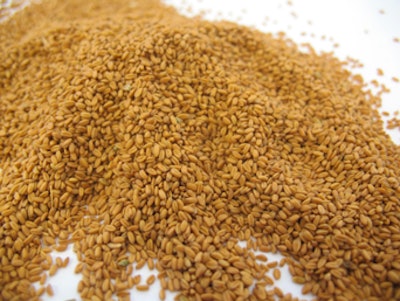
Camelina sativa is a plant with valuable potential for pig nutrition as a source of oil and protein.
The increasing demand for biofuel sources has resulted in recent increase in the production of camelina in Europe and North America, as the cost of oil production is lower in comparison with other oleaginous sources. In fact, camelina oil currently tested by the United States as a biofuel for its navy and air force, and similar tests are also undertaken in Europe.
Camelina, also known as “wild flax” or “false flax”, appears to be a potential alternative to flax oil as it contains exceptional high levels of n-3/n-6 fatty acids and protein. The omega -3, α- linolenic fatty acid is found in a large proportion in the composition of the camelina oil, 38-40 percent. Camelina oil also contains γ- tocopherols (vitamin E, 110mg/100g), the most powerful natural antioxidant, which increase the stability and shelf life of camelina oil compared with other sources of omega-3 oils.
The results obtained from several studies with camelina oil in growing-finishing pigs (carried out in the National & Research Development Institute for Biology and Animal Nutrition-IBNA, Balotesti, Romania) provide significant evidence in support of using camelina oil as a source of enhancing the nutritive value of pork meat.
Recently, an experiment was conducted using modern hybrid pigs (female Large White x Landrace by male Pietrain) for a period of 92 days (growing-finishing period) to evaluate the effects of camelina oil on pork meat quality. The experimental diet contained 3 percent camelina oil which replaced an equal amount of corn grain.
This substitution increased the level of α- linolenic fatty acid to 4.22 percent in the experimental feed versus 2.72 percent in the control diet (without camelina oil). The dietary addition of camelina oil showed positive effects on meat pork quality in terms of a significant increase in the level of total polyunsaturated fatty acids and specially in α- linolenic fatty acid content which was 4.93 and 3.38 times higher in Longissimus dorsi and Semitendinosus muscle from pig fed camelina oil than that of the control pigs.
As expected, ratio C18:2n-6/C18:3n-3 was significantly reduced in both muscles, and this was probably due to the significant increase in linolenic and docosahexaenoic fatty acids from camelina oil. Naturally, the level of n-3 fatty acids in pig muscles was highly correlated with the intake of these fatty acids.
These results indicate that camelina oil rich in n-3 PUFA has the capacity to modulate the fatty acid content in pork. As such, it appears to be a suitable feed ingredient as fat source for pig diets. Moreover, the n-3 PUFA content of camelina oil in the fattening phase may increase the nutritional value of pork and pork products, with beneficial effects for human health.















